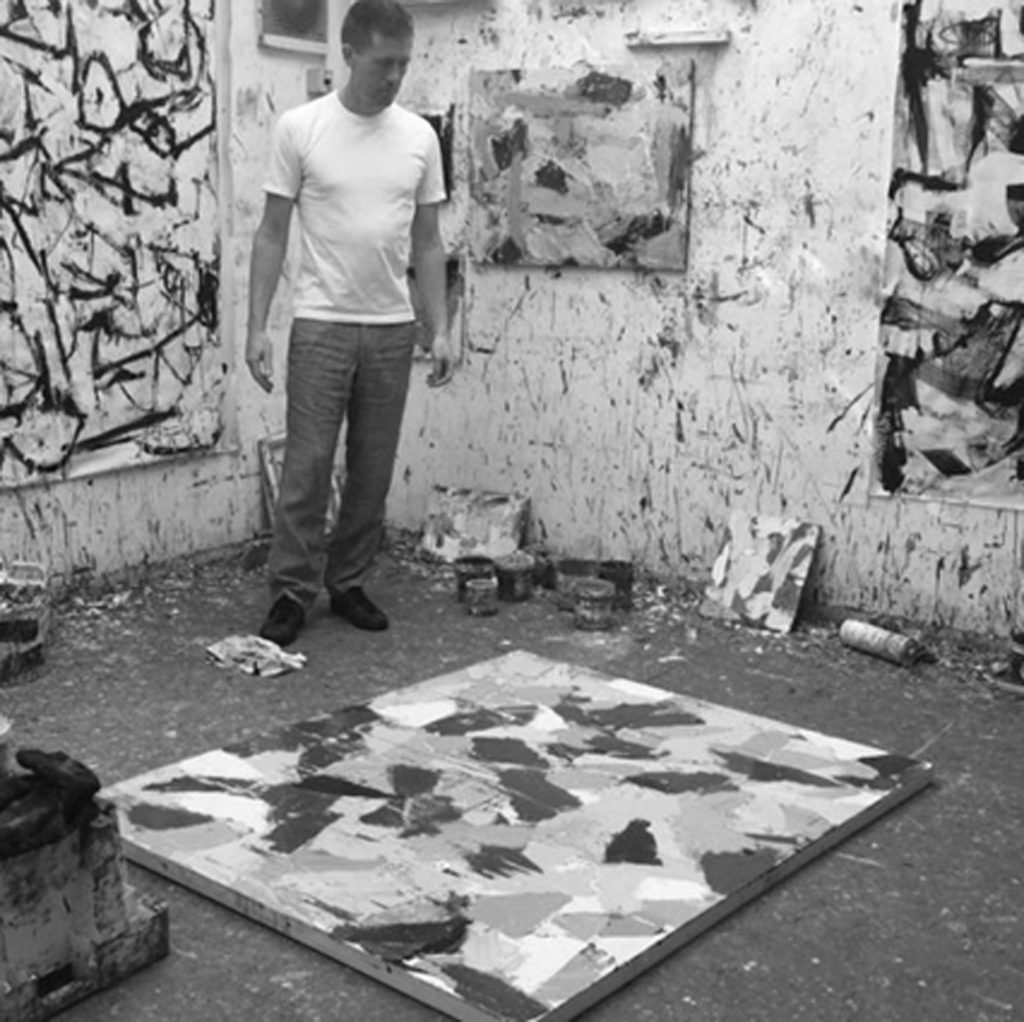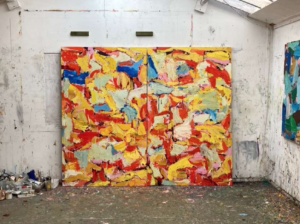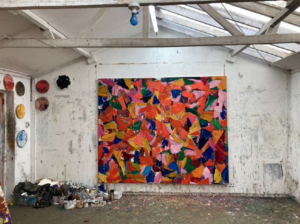
Receive the latest information and updates about the artist
Follow
Tom Robinson lives in Norfolk, England. His work space is a large garage-turned-studio without windows where light is drawn through opaque panes of glass in the ceiling. The work in progress is hung on each of the four walls surrounding the artist, creating an intense if sometimes claustrophobic atmosphere. The arrangement allows the works to speak to each other across the room and for different bodies of work – small and very large paintings; paintings on panel and canvas; paintings in vivid colour and in black and white – to proceed in concert.
Robinson describes his work as ‘reaching for something beyond the surface: the meta image’. His process is rooted in an intuitive approach in which formal elements are manipulated until an image emerges, hovering between stability and the possibility of a further realisation. It is an instinctive yet considered way of working. The paintings start from an inchoate impulse to use a particular colour,
movement or tone and, through the process of adding and subtracting, go on to establish a structure and logic of colour. Robinson places great importance in taking colour off the surface, as well as in applying paint. His understanding of colour is subtle and often surprising. The forms move against each other: coming forwards and receding to create space, and giving the surfaces a three-dimensionality akin to relief sculpture. His paintings often feel compact, elevating rather than mitigating the tension and visceral energy of the fluid, moving paint. One is left with the impression of complex, rhythmic planes of colour that generate light.
Robinson’s influences are myriad and eclectic and include literary and musical sources as well as the plastic arts. He first found the Greek and Assyrian reliefs in the British Museum as a student in London, igniting an interest that has shaped his understanding of rhythm and surface since. The overlapping forms and the particular perspective found in classical relief panels are tangible markers central to his paintings.
Robinson attended The Byam Shaw and The Royal Drawing School in London. He lives and works in Norfolk. He was shortlisted for the the Gilchrist Fisher award in 2010 and the Contemporary British Painting Prize in 2021.
I am interested in art that takes you to your senses: that registers as some sort of shock or force (subtle or strong). This could be a line; the outline of a jug against a wall; a rhythm; a colour. The list is endless. When you swim in a river, you connect through your senses — touch, nerves, you feel it through your skin and you are aware of the surface of the water and the light thrown off the surface and the dark under the trees. All of those sensations come before any thought. I am drawn to paintings and sculpture that seem to enter one through the senses.
I’ve thought for a long time about opposites and that a painting might be the sum of its opposites. That any formal element has an opposing counterpart (think of complementary colours; but the principle isn’t confined to colour: thus thin is opposed by thick [whether that’s a line or a field of paint]; light to dark; still to movement; fast and slow movement [movement is realised when it is arrested]; wet and dry; hard and soft edges; saturated or dull colour; a loose or tight structure; harmony and dissonance; near and far. But also less tangibly something unexpected might be funny — make one laugh — and others be oppressive. Matisse’s cut out show is a case in point – the paintings had this unparalleled force: certain colours and forms were the optic equivalent of strong drink; others seemed to overwhelm: to drive one into the floor. These opposing forces speak against and with each other. They create different voices, different registers. They create tension. somehow they create light. Painting can create skins of paint over an underlying skeleton of form. Painting can make concrete forms — a structure – within paint that is intrinsically liquid. Sometimes light is coloured; in other work white light is generated, the equivalent of daylight — Cézanne repeatedly made white light in his paintings.
I am drawn to music that does something similar. I have been listening to Karin Rehnqvist’s choral music. Its often harsh, but it seems to have a quality where it hovers and grips right on the edge of one’s nervous system. You feel it as well as hear it. Its beautiful and slightly ugly and strong and weird.
The process of painting: continual reiteration — something accrues; improvisation and finding something new. I think there are concerns — probably the light that each painter generates — that don’t really change, despite all the more superficial developments you go through. I feel quite close now, to the landscapes that I was making outside ten years ago and the drawings I was making in the British Museum of the Greek reliefs fifteen years ago as a student. At the same time you learn new aspects of the same things — about light or of putting things together — like learning the same thing over and over in a slightly new way. It’s perhaps akin to being in a dark room that gradually gets bigger as you learn to do more things; but you have to work to make sure you are always touching the walls.
Q&A Tom Robinson
in conversation with Dr Claudia Milburn
Q. What first inspired your practice as a painter, and when was this?
I came to painting through drawing. This was mainly drawing from the past, in the British museum, mainly the Greek reliefs. The reliefs from Bassae, Halicarnassus the Parthenon. Also during that period we spent a lot of time in the life room. Then on leaving London I started painting outdoors. We lived in a place with no public art and no culture of any kind and the most stimulating thing was the light. So that became my subject.
Q. What is your background / training and how influential has that been?
I started my life with quite an academic background; then found it wasn’t right for me and went to art school, which was right. Art school was very much about drawing. After that I painted for years on my own in the country outside in front of the subject. Some things have changed but the same root concerns, that were clear in the earliest drawings and in the paintings of landscape, are very much still at the centre of my work.
Q. Can you describe a typical day in your studio?
I go in relatively early and work until I have to leave. There’s generally a number of works being made. I don’t find it difficult to spend time working. I had a conversation a few years ago about building something; if you are building a house, it shouldn’t have a hole in it, the roof needs to be complete but those rules don’t pertain in art. The structure requires logic, but at the same time has to open up to permit the entry of the viewer’s imagination.
Q. Tell me more about your subject matter and the inspiration for your work?
Everything seems to change from day to day. Certainly it seems that you learn lessons over and over; so that things come up after years (realising something about tone for instance) that you know you knew years ago but have found out in a different way, again. Sometimes this is dispiriting: like you find something out and appreciate it consciously only to realise that actually it was present in your work six months ago, and probably came out more spontaneously. Other times I think these things crystallizing in one’s consciousness is helpful; it leads to being able to move further faster and more consistently. And I think that movement – the development in one’s practice – is key. David Sylvester said something about the greatest painters in the past sharing the characteristic of working to extremis. I think that’s the direction its important to head towards; and that it cannot be reached wilfully, only through the workings out of the work. Another way of saying this – or my understanding of it, is that one works not knowing.
Q. Gestural mark-making is strongly evident in your practice. Can you tell me more about your particular mark-making processes?
I think the marks are just what is necessary to make the change I want or need to make at any point. Braque wrote about loving the rule that bound the hand to the mind. I think that’s salutary.
Q. How significant is the element of serendipity in your work?
I don’t know. I heard someone talking about the importance of dirty brushes recently; my brushes are pretty clean. Maybe that’s an answer?
Q. What do you feel is your greatest challenge when painting?
Kossoff wrote about having to teach himself to draw each time he went to his subject. I have always felt the rightness of that statement. Its not so much a challenge, more a condition: having to find the way that the painting needs to go. When I am lost and try to find the way forward, its hopeless, I find, to backtrack: it doesn’t work for me. It needs to be a reaching forward, not relying on something I’ve already done.
Q. To what extent do you allow your paintings to evolve organically?
I don’t have any ideas. I stick pretty firmly to that. There is certainly an element of the painting being in some sense an arena in which something happens. I don’t find it useful, or possible, to straightforwardly exercise a preconception, perhaps no one does really. Instead it’s more like climbing a ladder. You decide to start and then the view changes as you go on from rung to rung.
Q. Could you discuss the dynamic between colour, form and structure in your work?
It’s not so easy to do that. One thing I have been thinking about is the sort of X and Y axis of a painting. Sometimes things seem to move around – like a child’s game where you have a board and an empty square and all the other squares have to be shunted until they’re resolved, albeit with the empty square remaining. Other times it feels much more that of a palimpsest. I don’t think its ever completely either. Instead, and this is common I think to everything, there are poles and you have to slide or wade between them.
Q. You have talked about being drawn to paintings and sculpture that seems to enter one through the senses. Who or what has been your greatest influence as an artist?
I wondered last night about what art I would most like to own. It was getting dark and I was also thinking about drinking and the work that came into my mind was Matisse’s cut outs. Those are what I’d most like to look at this week.
Q. I am interested in your analogies between painting, music and poetic form – could you elaborate on this?
Yes, I don’t know if they interact in a formal way. Maybe they do, buts that’s for someone else to say. I think they show what artifice can be capable of. There are things that stick in your mind. I remember hearing Brett Dean play a piece for solo viola. There is a sound made right at the beginning of the piece it’s at once onlythe noise that the instrument is able to make (which is completely electrifying: it pins you to the back of your chair) but it also seems completely right – it fills a space in your mind. I guess that’s to do with where it is in the music; what’s around it, how its been organised. And there’s also the fact that he can play. On the same night we heard a violinist – who was billed as virtuosic – playing his music too; but for me it was just a surfeit of proficiency, and felt inert.
Q. Where do you see yourself in relation to contemporary painting practice?
That’s definitely one for someone else to say. There are concentric circles of influence. Wide pools of amazing work that sort of push and pull you around a bit and are exciting but have quite tangential relevance. Then much smaller circles of work, contemporary or long dead, who make up what feels like the real world.
LONG READ: Tom Robinson Studio Visit
by Dr Claudia Milburn
Heading through the heart of North Norfolk I pass the magnificent view of Blickling Hall and continue my journey along the winding, undulating country lanes before arriving at the farming village of Saxthorpe, just 10 miles inland from the coast. My destination is the studio and home of painter Tom Robinson. On my arrival, I find a picturesque setting and a stimulating, imaginative environment – what was a dilapidated 1960s bungalow quirkily redesigned by the Robinsons as their family home, children playing in the garden, a rope swing hanging in the patio porch. The first impression was that of a creative and considered lifestyle – people who care about every aspect of their surroundings. It seemed idyllic.
Tom was immediately warm and welcoming, with an easy relaxed manner, reflective of his kind and affable personality. We walked over to his studio – a converted garage in close proximity to his house. The southern side of the studio had been replaced with glass panels, painted white and the window had been boarded across to make more wall space. It created a studio environment akin to a large luminous box.
I glanced around and absorbed my surroundings. The paintings hanging on the studio walls offered a kaleidoscope of rhythmic colour exuding luminosity and with the energetic brushstrokes of their making animating the studio environment. Further canvases were stacked on the floor, a combination of work completed and work in progress. A mass of squeezed paint tubes formed a sculptural mound consuming one corner of the studio while painted ceramic plates hung on the wall – experimental ideas concerning colour relationships, each an individual artwork in itself. Paint splatters covered every inch of the studio – the splashed walls evidencing the activity having taken place in the space. The kinetic energy present on the surface of the works echoed in the studio surrounds. Tom stood camouflaged in his environment – his clothes similarly covered in paint including his fleece jacket which had clearly seen him through painting during the dark, cold winter months from which we were gradually emerging.
Tom is a serious and committed artist with a calm, unassuming personality.


We chatted freely and easily about his work, and about art and life in general, immediately connecting with a sense of shared mindset and outlook. It was not difficult to engage with his paintings and express my sincere enthusiasm. He revealed one large, stacked canvas after another, moving them around and either hanging them up or propping them by the wall. Through this viewing process, I gained further insight into the mind and motivation of the painter. I have never failed to get excited by colour, and here was an artist who truly knew and understood colour, each dynamic interaction of one hue against the next creating a new drama, set of tensions and intensity. The paintings were alive with the vitality of Tom’s approach, paint marks dancing across the surface, fresh and captivating.
We walked over to a large greenhouse in the garden where canvases hung drying – a surreal way to view paintings among the soil and plants, but appropriate – a coming together of nature and art, redolent of the priorities in his family life. The winter sun filtered through the glass, warming the greenhouse and brightly illuminating the works.
School, his early experience of painting and the influence of painters including David Bomberg and Frank Auerbach to the evolution of his current practice.
I left my studio visit feeling enriched with colour, inspired by Tom’s approach and with a genuine sense of new friends established.
Tom has a new exhibition ‘In Between Them Doing’ opening on Wednesday 6 July.